If it’s a traditional Harley-Davidson you’re after, you won’t find it in the Pan America 1250 Special. But if it’s a high-tech adventure bike you crave, you’ve come to the right place
Harley-Davidson is not messing around with its first serious crack at the booming adventure-bike market. It’s so confident in its all-new Pan America 1250 Special, in fact, that it’s pushing to be number one in the over-601cc adventure bike category in Australia.
Yes, you read that right. At the Aussie launch of the Pan America, local H-D boss Nigel Keough was pulling no punches when he said, “I had the opportunity to ride a pre-prod about two-and-a-half years ago in Milwaukee and I was really impressed, and here we are two-and-a-half years later and we have put more development, more money into it, to make it what we believe will become Australia’s favourite adventure tourer.”
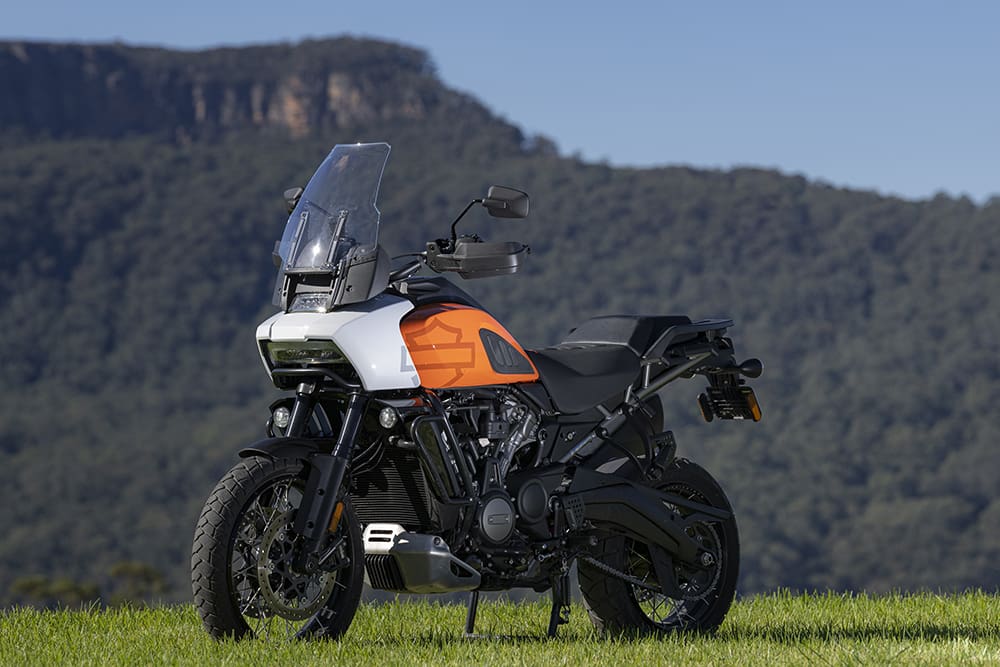
That’s some serious ambition. To achieve that lofty goal, not only will the Pan America have to take on the likes of BMW’s legendary R 1250 GS, KTM’s 1290 Super Adventure and Ducati’s Multistrada V4, but it will also have to convince potential buyers that a Harley-Davidson adventure bike is the real deal, and not at all like any other Harley-Davidson before it.
After riding the Pan America 1250 Special at its recent Australian launch, one thing is for sure – it is nothing like a traditional Harley-Davidson. But is it good enough, and adventurous enough, to take on the established players in the market?

If you take a look at the specs alone, the answer is a resounding yes, because the 1250 Special certainly has the goods on paper, including a 112kW (150hp) V-twin engine, a competitive 258kg ready-to-ride wet weight, a bagful of high-tech traction aids, a super-trick semi-active suspension system, a full complement of optional accessories, gear and luggage systems and much more.
Harley-Davidson makes no secret of the fact it benchmarked key competitors when developing the Pan America, and it reckons it has them licked. While we can’t make that call just yet – not until we’ve ridden the Pan-Am alongside its competition – there’s no doubt that in isolation this new beast from Milwaukee appears to be a seriously competent premium adventure tourer.

The Pan America 1250 Special (the only model on offer in Australia) starts at $31,995 (in Vivid Black) ride-away, and for the money it is absolutely loaded with standard kit and technology. If you have some cash burning a hole in your pocket, there are also a few options including premium Deadwood Green or Gauntlet Gray Metallic paint (+$295); two-tone Baja Orange & Stone Washed White Pearl finish (+$645); and a laced wheel and adaptive ride height package (+$1485).
“It’s a really competitive market segment,” admitted Keogh at the launch.
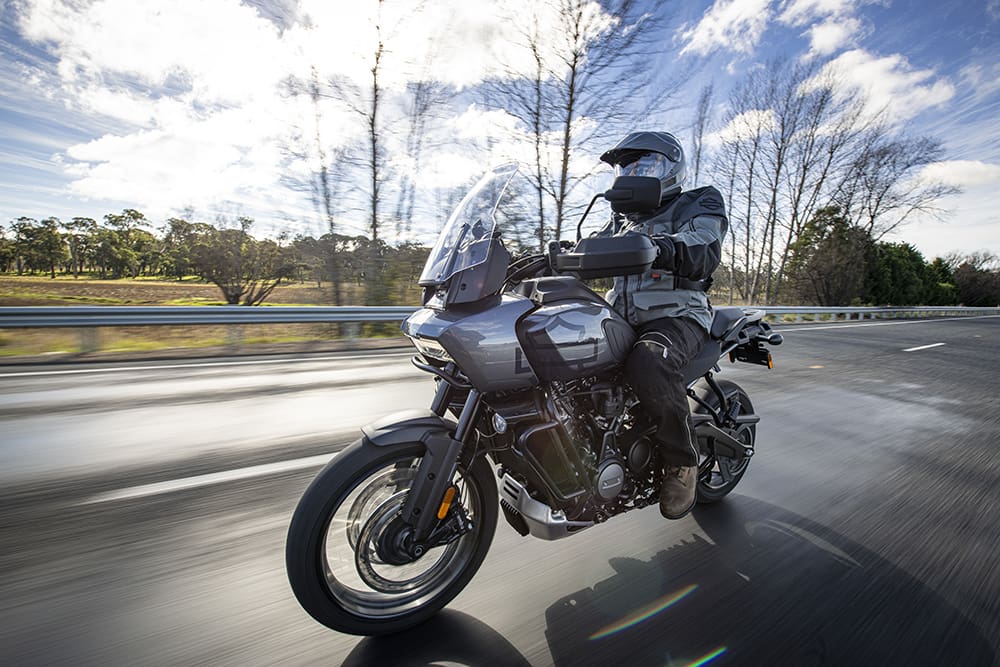
“But we believe that the bike, the features and the brand will bring something very unique to the marketplace.”
And unique it is… at least to look at. There are some obvious adventure-bike elements in its design, brought about by form-follows-function and all that, but there are plenty of non-traditional elements too, including that V-twin engine standing out like the jewel in the crown, and the H-D Bar & Shield logo across the tank and fairing.
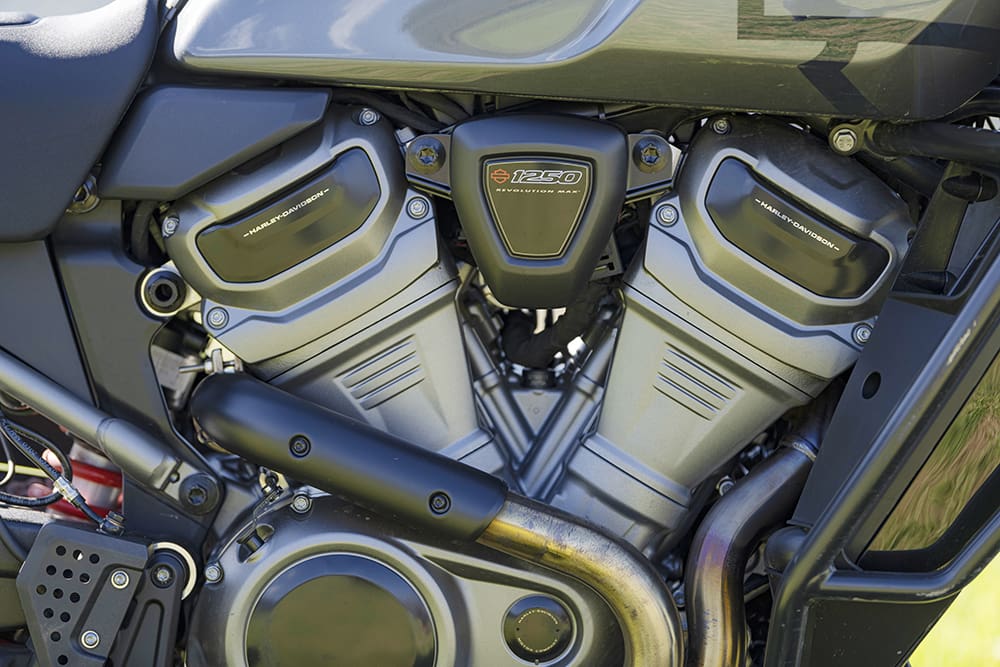
And, of course, the stacked horizontal headlight cluster. Given online feedback, it seems as though H-D has come up with a somewhat polarising design, but most of those present at the local launch agreed it looks much better in the metal than it does in any photos. By the way, that stacked horizontal LED headlight is not there for looks alone; it incorporates Advanced Daymaker Adaptive Headlamp technology; sequentially illuminating LEDs that light up as the bike leans – at eight, 15 and 23 degrees – to gradually provide additional lighting where it’s needed when cornering.
Yep, advanced tech is a big part of the Pan America story, and that advanced lighting system is only a small chapter…
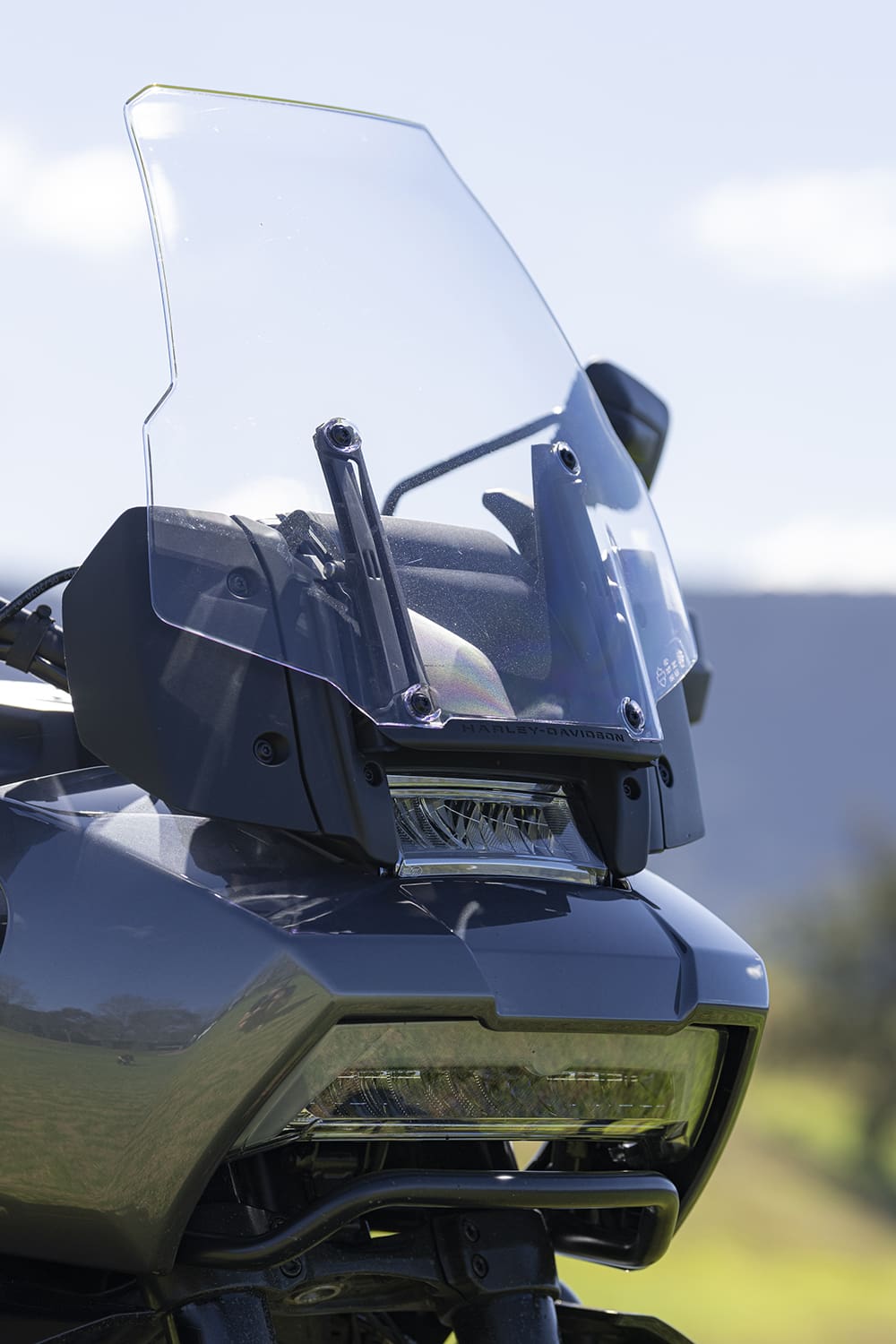
Another unique element of the Pan America is just how easy it is to throw a leg over the seat. All the bikes available at the local launch were equipped with optional Adaptive Ride Height (ARH), which lowers the bike by 25-50mm by automatically reducing rear-spring preload as the bike comes to a stop. The result? With the suspension at its lowest setting, and the standard seat at its lowest setting, overall seat height is just 830mm. Not low enough? There’s even an optional low seat for super shorties, making this a big adventure machine for riders of any stature. Ride away from standstill, however, and the suspension automatically (and imperceptibly) rises to provide an off-road capable 210mm (static) of ground clearance.
Being able to sit at standstill with both feet planted firmly on the ground is a nice change from the tip-toe stance I’ve had to adopt on many other adventure bikes, making it easy to familiarise myself with the Pan America’s controls and instruments before setting off. And on this high-tech bike there’s plenty to get familiar with, including all those switches on both sides of the ’bar, the adjustable screen and the comprehensive 6.8-inch colour TFT touchscreen.
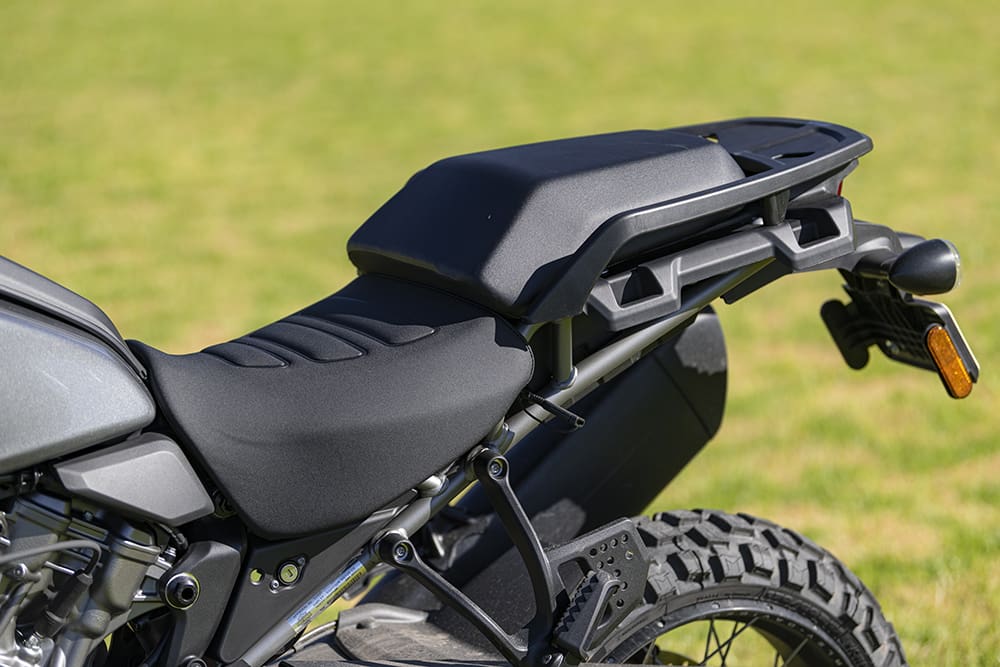
That big touchscreen can be angled to suit rider height and it provides just about all the info you’d ever need, including central digital speedo, analogue-style digital tacho, ride mode, clock and fuel level, etc.
As well as the glove-compatible touchscreen, you can scroll through info on the TFT display by using the ’bar-mounted switches, which are quite intuitive to use with some familiarity. There’s a standard tyre pressure monitor (TPMS) and thanks to Bluetooth connectivity and the Harley-Davidson App (iOS and Android devices), the TFT screen can also be customised to display turn-by-turn navigation, infotainment details and voice calls info, all while retaining the speedo, turn signals and other critical information.
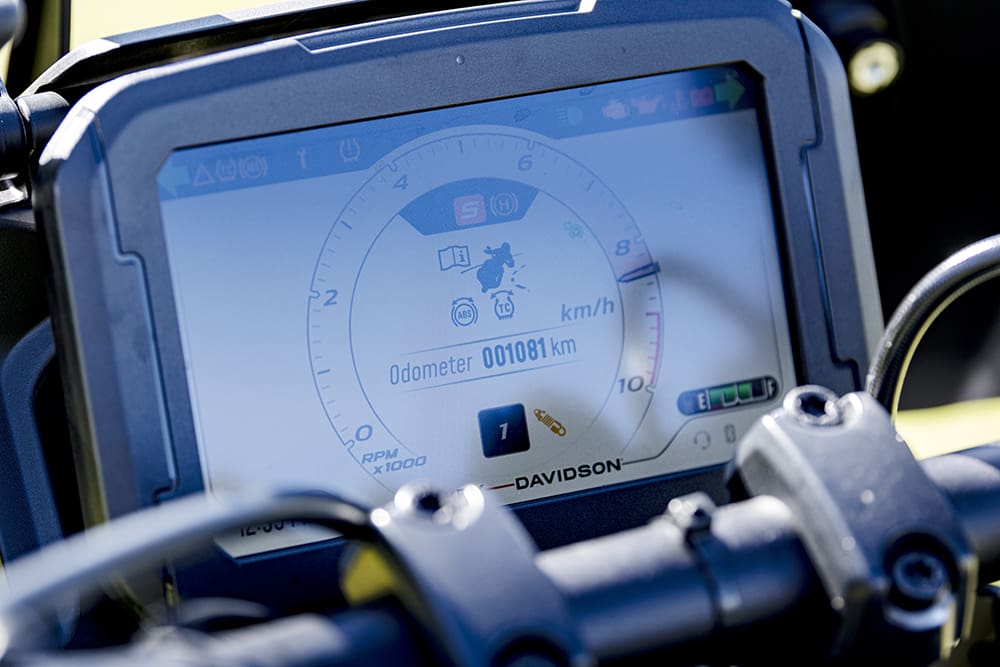
There’s no denying the Pan America is a big bike, but H-D has put a lot of effort into minimising overall weight; fully fuelled and ready to ride it tips the scales at 258kg. Once moving, and with the seat in its lowest position, the Pan America didn’t feel nearly as big as I thought it would. Sure, the handlebar is wide but it’s not a long stretch away; the footpegs are an easy reach for my not-so-long legs; and that generous 21.2L fuel tank is quite narrow where it meets the seat.
At the heart of the Pan America is its all-new 112kW Revolution Max 1250cc 60° V-twin engine, and it’s not like any other H-D V-twin before it. In fact, H-D says there is not one single carry-over component from any previous Harley-Davidson.
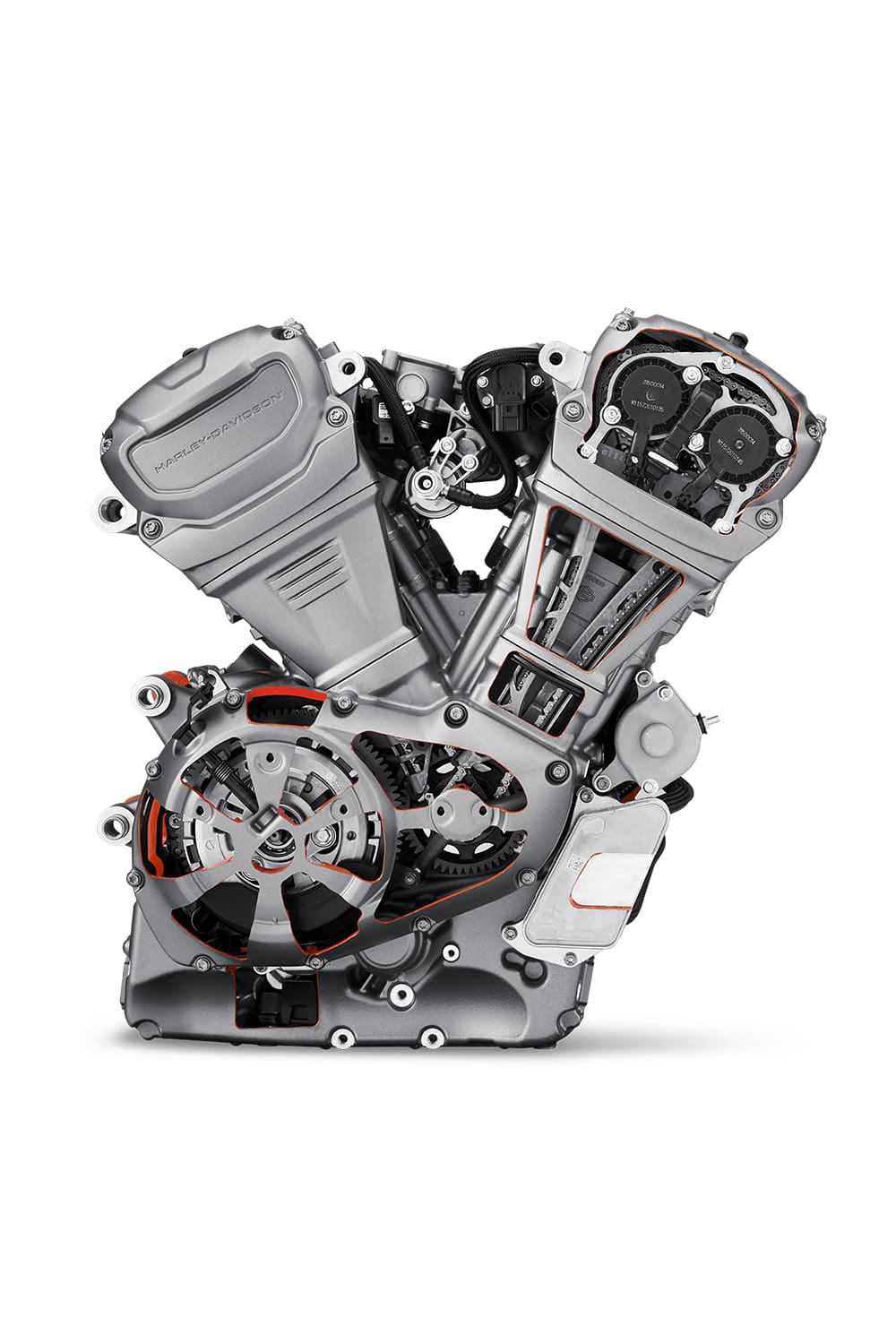
The engine features double-overhead cams, four-valves per cylinder and Variable Valve Timing (VVT). Hardly revolutionary stuff in the automotive world, but certainly revolutionary for Harley-Davidson. The crank has a 30° offset resulting in a 90° firing order, and this, combined with two gear-driven balancers (one up in one of the heads and the other down in the crankcase), minimise vibration throughout the rev range, even way up at… wait for it… the 9500rpm redline.
Another trick engine feature is the water-cooled oil cooler, which has been designed to provide a very consistent oil temperature and water temperature in a wide range of riding conditions, which is a good thing for a bike that could one day be cruising along in sub-zero ambient temps and the next day be slogging through desert sands with the mercury nudging 50ºC. There are also hydraulic tensioners in the cylinder head and a “tiny” roller rocker that runs off the camshaft, which is claimed to provide a maintenance-free top-end.

Fire up the Rev Max and it sounds like no Harley-Davidson V-twin before it. No lumpy idle here; more like a smooth hum accompanied by a muffled but pleasing exhaust note. As intended, the Pan Am’s V-twin offers plenty of low-rpm torque, a linear power delivery and impressive throttle response, making it easy to plod along at slow speeds, but once on the open road, and with an opportunity to open it up, it responds with plenty of gusto, especially once the tacho needle is north of 7000rpm. And it will rev happily all the way to 9500rpm when the rev limiter says, “time to upshift, mate”.
But there really is no need to explore the top-end too often because there’s plenty of grunt in the midrange; just crack the throttle from 3500rpm or so and the engine responds almost instantly, and with enthusiasm.
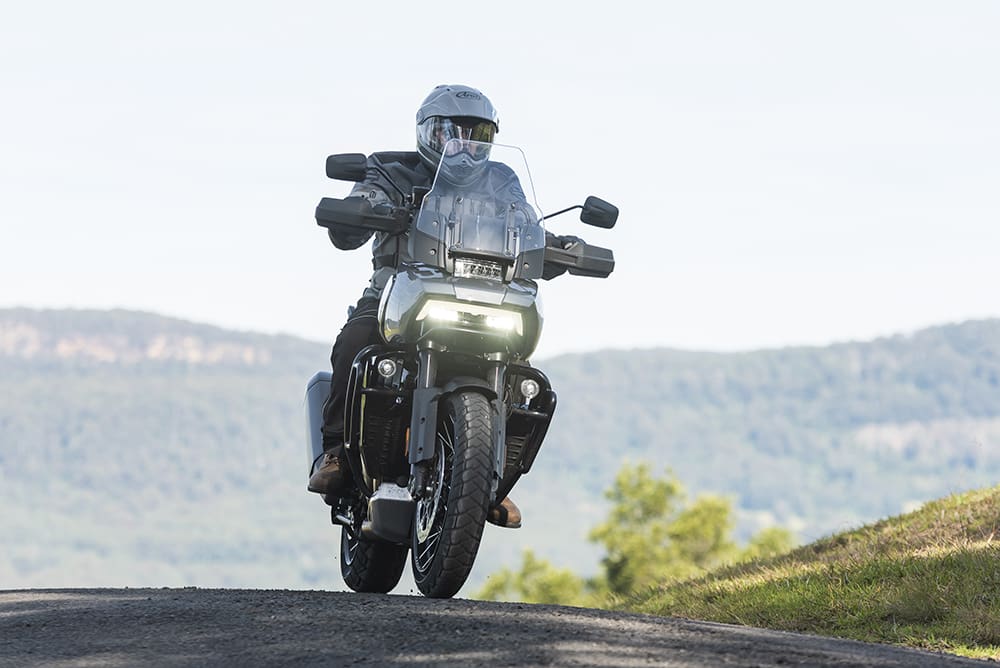
Want more power for a quick fang, or less power for sketchy conditions? Engine response can be quickly adjusted by selecting different riding modes via a button on the right ’bar, and these modes also adjust other parameters including suspension settings and the level of rider-aid intervention. The pre-programmed ride modes include Road, Sport, Rain, Off-Road and Off-Road Plus, while there are also two Custom Modes that allow the rider to tailor settings to suit their skill level and riding conditions (See boxout).
The lack of a quickshifter is a notable omission, but the six-speed gearbox offers smooth and positive shifts both up and down the ratios.

While the Pan America’s Semi-Active Suspension hardware is supplied by Showa, the control software has been developed in-house by Harley-Davidson. On the hardware front, the suspension consists of 47mm USD Showa BFF (Balance free Forks) with semi-active damping control up front, and a Showa BFRC (Balanced Free Rear Cushion-Light) shock with electronic preload control and semi-active damping control at the rear. Suspension travel at both ends is a handy 190mm.
The Pan America uses what is called a Vehicle Loading Control system to sense the weight of the rider (and pillion and luggage when applicable) to set the optimum suspension sag by automatically adjusting the rear preload. It then reacts to a variety of inputs (suspension position, vehicle speed, vertical acceleration of the motorcycle, roll angle, roll rate, rider applied throttle and applied brake torque) to maintain optimum comfort depending on the selected ride mode. Pretty trick, eh?

In practice, Semi-Active Suspension means you can simply select the ride mode to best suit the conditions and the ride quality will always be optimised. On most sealed roads the ideal setting is, as you’d expect, Road Mode, which offers good compliance and good control. If you want to press on a bit, Sport Mode firms everything up, so there’s less compliance but better damping control. It might sound complicated but, in practice, it’s simple to use and it just works.
The linked brakes feature Brembo four-piston radial-mounted Monobloc calipers up front gripping 320mm discs while there’s a single-piston caliper at the rear and a 280mm disc. The stoppers offer good feel and strong performance, as well as the reassurance of cornering-ABS.
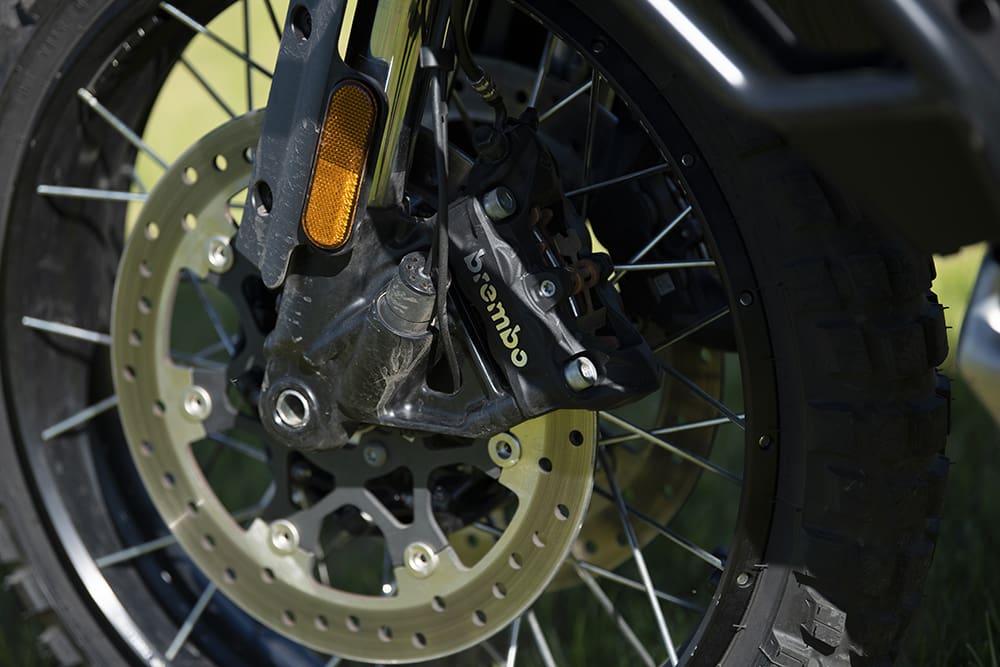
The rear brake pedal can be quickly adjusted for an easier reach when standing on the ’pegs for off-road riding; simply pull it out and flip it over. The stand-up riding position is good, too, with an easy reach down to the handlebar, and a tank and seat shape that makes it easy to grip with your legs. And the footpegs have removable rubber inserts that can be quickly removed if conditions turn slippery.
The gravel road section on the launch ride wasn’t particularly slippery, nor was it demanding, but it did offer a sample of how the Pan America behaves on unsealed roads, and it was pretty confidence inspiring. With Off-Road Mode selected, the precise throttle response made it easy to get the rear wheel to spin up when desired but also easy to maintain traction when needed. It was also easy to change line at the last second to avoid potholes and the like, while the suspension did a good job of soaking up bigger hits.

The off-road section of the launch ride? Little more than a grass track cut into an undulating paddock; not too challenging… but pretty bloody slippery, even on the bikes fitted with optional off-road rubber! It’s in conditions like these that the precise throttle response is appreciated, along with the light and progressive clutch action.
If the grass track did show off one thing, it’s that the Pan America is easy to manoeuvre at low speeds for what is a big bike, which will no doubt come in handy in tight off-road conditions.
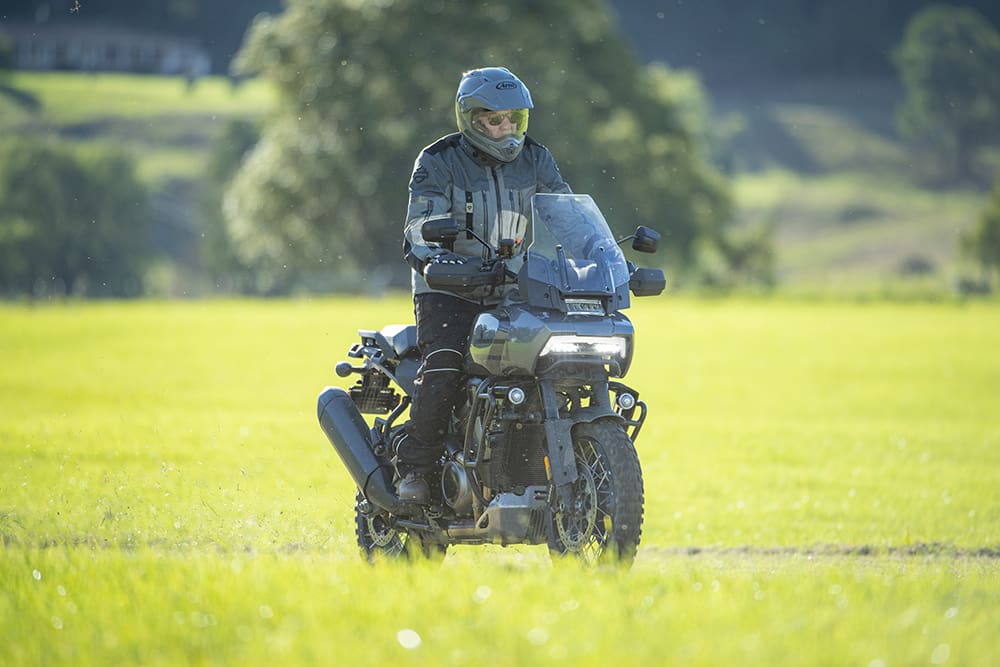
Those who want to take the Pan America off-road will be reassured by tubular-steel brush guards that offer protection for the radiator, as well as the skid plate that offers reasonable protection to the underside of the engine (there’s also an optional, more substantial skid plate available). The front indicators are also located out of harm’s way (almost within the fairing), and the centrestand is standard fitment on the 1250 Special.
At highway speeds the standard screen offers good protection and is easily adjustable for height, and, if it’s super-cold, the standard wind deflectors on the handlebar and the three-level heated grips will keep your digits toasty warm.
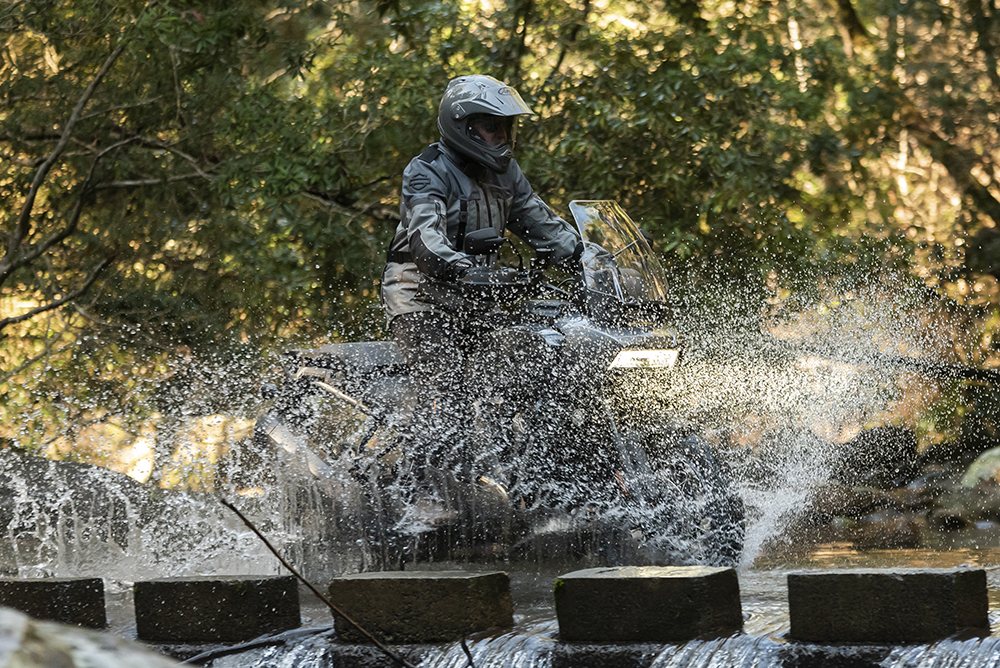
There’s no doubt Harley-Davidson has built a genuine adventure bike in the Pan America, and first impressions suggest it has built a pretty good one. Good enough to topple the established players and claim the mantle as “Australia’s favourite adventure tourer”?
That’s a big ask, and a question we won’t attempt to answer until we’ve pitted the Pan America against its direct competitors, which is a job we’re absolutely itching to do. Keep an eye out for AMCN’s upcoming adventure issue to find out…
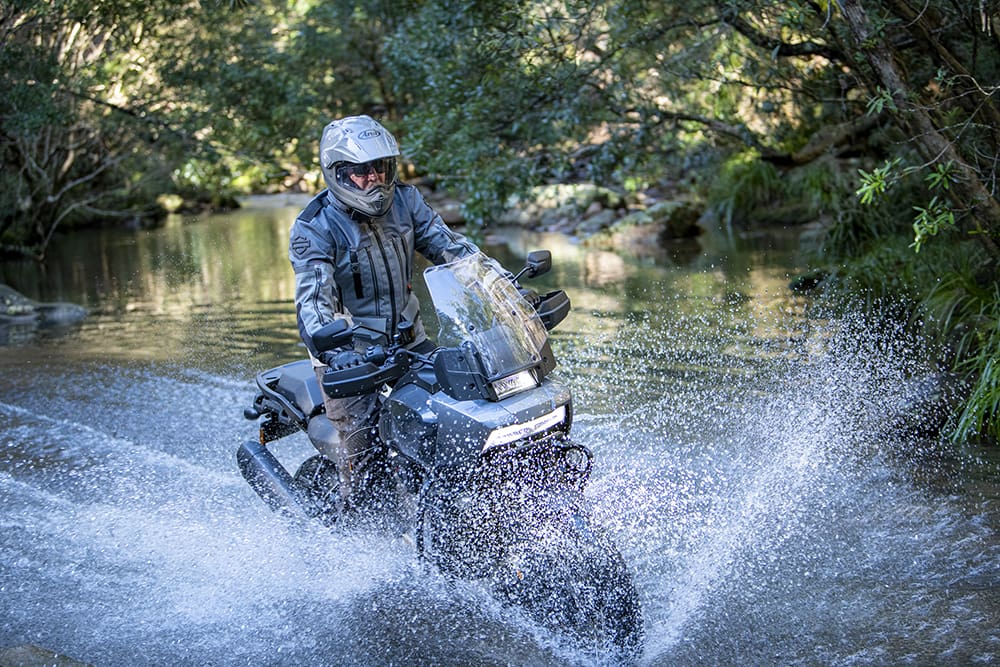
Test Dean Mellor Photography Incite Images